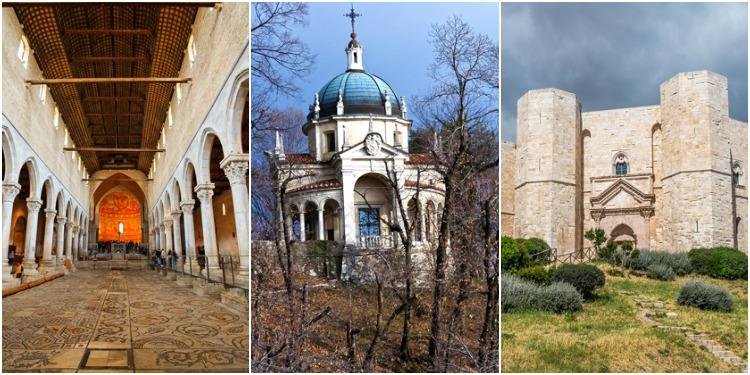Italy has the highest number of UNESCO World Heritage sites in the world (51), but are you familiar with all of them? Here are three impressive yet little-known places you should include in your Italy travel list (or lists).
Archaeological Area and the Patriarchal Basilica of Aquileia

[Photo: Patriarchal Basilica of Aquileia with mosaics.]
Where: northern region of Friuli-Venezia Giulia, province of Udine.
History: Aquileia was one of the largest and wealthiest cities of the early Roman Empire, reaching a population of 100,000 people in the 2nd century AD (today, it has approximately 3,500 inhabitants). Founded in 180/181 BC by the Romans along the Natiso river, about 10 kilometers from the Adriatic sea, Aquileia originally served as a military outpost and was intended to protect the Veneti, faithful allies of Rome, against the Barbarians. Through the decades, it became increasingly important as a trade center thanks to its large river port and its strategic position, well connected to other Roman cities. Aquileia was destroyed by Attila and his Huns in the mid-5th century, yet the city rose again. From the Middle Ages to the 18th century, Aquileia was a hub for the Christian world of Central Europe as it was made seat of the Ecumenical Patriarchate.
Site: Aquileia is one of the main archeological sites of Northern Italy. According to UNESCO, “most of it still lies unexcavated beneath the fields, and as such it constitutes the greatest archaeological reserve of its kind.” Still visible in part are the Forum (heart of public life), the Basilica (Roman government building), the macellum (indoor produce market), the circus (racing arena), the baths, the Mausoleum, residential complexes, defensive walls, the Sepolcreto Romano, the amphitheater, the ruins on the river port. The most important building within the site is the Patriarchal Basilica, the symbol of Aquileia, completed in 1301, built over the ruins of a 4th century BC religious complex destroyed by the Barbarians. The interior is particularly noteworthy for its 4th century mosaic floor depicting scenes from the Old Testament, which was not discovered until the beginning of the 1900s. The Patriarchal Basilica played a key role in the evangelization of a large region of central Europe.
Why it was inscribed on the World Heritage List: As explained on the UNESCO World Heritage site: “Aquileia was one of the largest and most wealthy cities of the Early Roman Empire; by virtue of the fact that most of ancient Aquileia survives intact and unexcavated, it is the most complete example of an Early Roman city in the Mediterranean world; the Patriarchal Basilican Complex in Aquileia played a decisive role in the spread of Christianity into central Europe in the early Middle Ages.”
Sacri Monti of Piedmont and Lombardy

[Photo: Sacro Monte of the Rosary, Varese.]
Where: There are nine Sacri Monti positioned in the northern regions of Piedmont and Lombardy. They are: Sacro Monte or Nuova Gerusalemme of Varallo Sesia (1486), Varallo Sesia, province of Vercelli; Sacro Monte of Santa Maria Assunta, Serralunga di Crea (1589), province of Alessandria; Sacro Monte of San Francesco, Orta San Giulio (1590), province of Novara; Sacro Monte of the Rosary, Varese (1598); Sacro Monte of the Blessed Virgin, Oropa (1617), province of Biella; Sacro Monte of the Blessed Virgin of Succour, Ossuccio (1635), province of Como; Sacro Monte of the Holy Trinity, Ghiffa (1591), province of Verbano-Cusio-Ossola; Sacro Monte and Calvary, Domodossola (1657), province of Verbano-Cusio-Ossola; Sacro Monte of Belmonte, Valperga (1712), province of Turin.
History: A Monte Sacro - Sacred Mountain - is a Christian creation dating from the late 15th century; it is a devotional complex, built on the slopes of a mountain, featuring a series of chapels containing scenes from the life of Christ, the Virgin Mary or the Saints, in the form of painting or sculptures. Sacred Mountains emerged during the Counter-Reformation in Italy and later spread to many parts of Catholic Europe and the New World. For pilgrims, they represented a way to visit the Holy Places because, on a small scale, they aimed to evoke the New Jerusalem and the buildings where Christ's Passion took place. The Sacred Mountains stand on high ground, at some distance from the town center, in a natural setting. They are usually reached by pilgrimage.
Sites: The Sacri Monti of Piedmont (7) and Lombardy (2) are nine groups of chapels created in the late 16th and 17th centuries. They house many artistic works, including paintings, statues and frescoes, and are impressive in the way they were built to merge beautifully with the surrounding natural landscapes of hills, forests and lakes.
Why they were inscribed on the World Heritage List: As explained on the UNESCO World Heritage site: “The implantation of architecture and sacred art into a natural landscape for didactic and spiritual purposes achieved its most exceptional expression in the Sacri Monti (‘Sacred Mountains’) of northern Italy and had a profound influence on subsequent developments elsewhere in Europe; the Sacri Monti of northern Italy represent the successful integration of architecture and fine art into a landscape of great beauty for spiritual reasons at a critical period in the history of the Roman Catholic Church.”
Castel del Monte

[Photo: Castel del Monte, Puglia.]
Where: Andria, Barletta-Andria-Trani province, Puglia.
History: Castel del Monte (Italian for "Castle of the Mountain") was built in the 13th century by Emperor Frederick II, who had inherited the lands from his mother Constance of Sicily. Frederick was responsible for the construction of many castles in Puglia, but Castel del Monte's geometric design was unique. The emperor imbued it with symbolic significance, as reflected in the location, the mathematical and astronomical precision of the layout (studied so as to create symmetries of light during the winter solstice and summer equinox) and the perfectly regular shape (which uses eight as a guiding number). Built on a small promontory in the Murge plateau, near the monastery of Santa Maria del Monte, the fortress is an octagonal prism with an octagonal tower at each corner. Both floors have eight rooms and an eight-sided courtyard occupies the castle's center. The castle’s symbolism still intrigues scholars.
Site: In the 18th century, the castle's interior marbles and remaining furnishings were looted. It has neither a moat nor a drawbridge and some scholars have argued that it had never been intended as a defensive fortress, but rather a hunting lodge; however, archaeological work has suggested that it originally had a curtain wall. The main entrance reproduces the classic triumphal arch. The Castle's interior features high, cross-vaulted ceilings, but has none of its original decorations. Castel del Monte is considered a unique piece of genius medieval military architecture, blending elements of diverse styles and traditions from different times in history: classical antiquity, the Islamic Orient and north-European Cistercian Gothic. (Fun fact: Castel del Monte appears on the Italian version of the one-cent euro coin).
Why it was inscribed on the World Heritage List: As explained on the UNESCO World Heritage website, “the site is of outstanding universal value in its formal perfection and its harmonious blending of cultural elements from northern Europe, the Muslim world, and classical antiquity. Castel del Monte is a unique masterpiece of medieval military architecture, reflecting the humanism of its founder, Frederick II of Hohenstaufen.”





